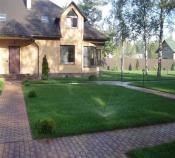Search
Login
Recommended
Liquid thermal insulation of armor, what is it, where methods of applying liquid thermal insulation of armor are also used
Need to quickly, efficiently, with a small expenditure of time, effort, and also finance, to insulate the roof, floor, walls or pipes in a house or garage, moreover, in a finished, built room, without reducing its usable area ?! Nothing is easier! And today it’s not a fairy tale and someone’s fantasies, but liquid thermal insulation proven by years of space flights, technology! What it is, how and why it is used, we will tell you about the unique development of Russian scientists of liquid heat insulation armor as an example.
Content
- What is liquid thermal insulation
- Scope of liquid thermal insulation
- Liquid Thermal Insulation Armor: Specifications and Applications video video
- Liquid insulation or conventional insulation: comparative
What is liquid thermal insulation
Everyone knows that many of the scientific developments that we are currently widely using come to us from the military or space industries. Liquid thermal insulation, originally used for thermal insulation of spacecraft, was no exception.
It is clear that the spacecraft has a high-precision mechanism, therefore increased requirements are placed on the hull of space rockets and shuttles and stations:
- withstand low temperatures in outer space, reducing heat loss.
- be light and durable
- resistant to aggressive environmental factors, corrosion, while on Earth

And all this, indeed, can be achieved through liquid thermal insulation.
What is liquid thermal insulation?

Liquid insulation – liquid polymer composition consisting of acrylic and rubber binders, ultra-thin ceramic microspheres containing discharged air, catalysts and fixing components, with anti-corrosion additives, applied as a paint, with a layer of 1 to 6 mm on any materials and surfaces. In liquid form, liquid thermal insulation has the form of a paint, after application and drying, it becomes similar to a polymer elastic and durable coating film. Application is made in several layers, and the operation of liquid thermal insulation is possible at almost any temperature.
Liquid thermal insulation under conditions of use in the energy and construction sectors provides:
-thermal insulation of surfaces and, as a result, a significant reduction in heat loss,

-protection of wooden, concrete and metal surfaces from moisture, acids, alkalis, temperatures,
-protection of people from possible thermal effects of the coolant in pipes, boilers, etc.

-saving spacedue to the small but productive thermal insulation layer,


-saving time, due to quick and easy application: we prepare the surface, as for ordinary painting, we apply liquid thermal insulation using a spray gun and brush, in several layers. Drying time of 1 layer 1 day.

-saving money.By itself, liquid thermal insulation is not a cheap product, from $ 20 for 1 liter, but, and the consumption of liquid thermal insulation is 1 liter per 1 sq. m., in the final (multi-layer version of thermal insulation). But, thanks to the possibility of applying liquid thermal insulation independently, quickly, without using all the components of a classic thermal insulation cake: frame, hydro- and vapor insulation, insulation - with a guaranteed service life of more than 15 years, it becomes obvious that liquid insulation is a cost-saving .
Based on this, the scope of liquid thermal insulation is practically unlimited.
Scope of liquid thermal insulation
Consider specific examples of the use of liquid thermal insulation in our daily lives:
- insulation with liquid thermal insulation of walls, floors, roofs and window slopes (both outside and inside), while the surfaces are breathable.

-insulation of pipelines (both hot and cold water supply), boilers, heat points, both industrial and domestic scale.

-protection from harmful environmental factors:
- used as heat and waterproofing under the screed,
- the insulating layer of the metal structures of the house, which eliminates the likelihood of condensation on them,
- as a protective layer of the surface of the walls outside and structures located in the open.

Liquid Thermal Insulation Armor: Specifications and Applications
Liquid thermal insulation of armor in the way of possible harmful, aggressive effects on the surface of materials, which is probably why Volgograd Innovation Resource Center called its brainchild exactly that - Armor.
Liquid insulation Bronya is a Russian analogue of American developments, improved and affordable.
What is so remarkable about liquid thermal insulation armor reviews of which, at the moment, are only positive?
A wide range of products under the brand name Bronya: Classic, Antikor, Zima, Fasad, Light, with technical specifications already prescribed and tested, make the selection and application of liquid thermal insulation Bronya even simpler and more productive:

Ultra-thin liquid thermal insulation armor is an environmentally friendly and safe product for humans. Moreover, not only during the application, but also the operation of burns from touching hot pipes and boilers covered with a layer of Armor will not!

Apply and use:
At the same time, the armor is not combustible, easy to apply, dries quickly, and has been used for decades without problems.
Liquid insulation or conventional insulation: comparative
Liquid insulation armor to buy or not? The question can be resolved after you familiarize yourself with the results of a small improvised battle between the traditional method of insulation and the use of liquid thermal insulation Bronya:






